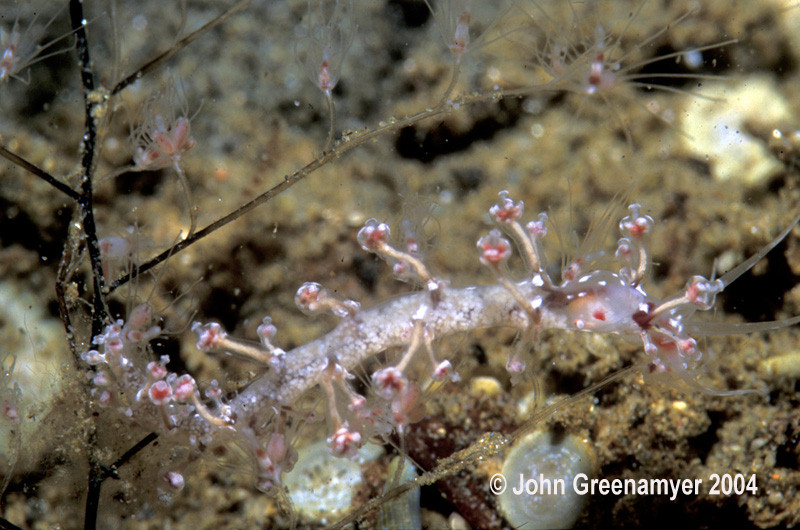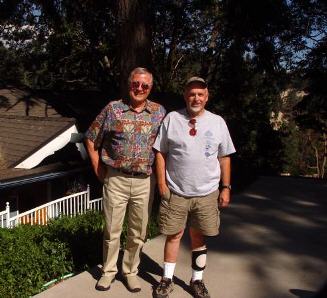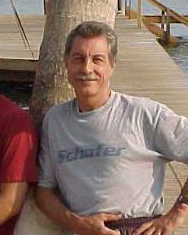 |
Hydroid Mimic
Photo courtesy of John GreenamyerMilne Bay, PNG
Hydroid "mimic" (species unknown)
Several species of sea slugs have developed incredible camouflage mechanisms to hide from predators. John Greenamyer’s photo above is a super example of a species that has mastered this art well. I have not been able to identify this species, and it may in fact be undescribed. There is a picture of it on page 244 of Rie Nakano's Opisthobranchs of the Islands of Japan.
The amazing character seen in this species is the similarity between the morphology of it's cerata and that of the polyp of the tubularid hydroid it is feeding on. Notice the cream colored ceratal core that matched the stalk of the hydroid polyps and the white and red nodules seen in the swollen end of each ceras. This is amazing similarity to the color and morphology of the hydroid polyp. The only piece that is missing would be the tentacles of the polyp.
A similar aeolid species that also resembles tubularid hydroids and does have cerata bearing tentacle-like protuberances is Cuthona kuiteri as seen on Bill Rudman's Sea Slug forum. Both of these species are practicing double defense strategies, having both stinging cells in the cnidosacs at the end of each ceras, and the ability to go undetected while on their prey.
Some have termed this phenomenon – Mimicry, as I have above, but I believe the strategy to be more accurately referred to as "Protective Resemblance. Other wonderful examples of this defense strategy include Bruce Potter’s sacoglossan Algal "mimic", and Melibe australis that displays a very wide range of colors and ceratal morphologies, one of which perfectly resembles the colonies of a tunicate. Another is Mike’s BOW week 105, an undescribed Phyllodemium whose ceratal morphology perfectly matches the closed polyps of the soft coral, Xenia. Of course, then there are many dorid nudibranchs that look identical to their sponge prey species, and others such as Corambe pacifica , that is invisible on the encrusting kelp bryozoan, Membranopora.
John – this was a great discovery. Thanks for sharing it. Now we need some specimens.
Danville, Calif
Dec. 2004
John Greenamyer and Webmaster at Running Springs
Photo courtesy of Alan Grant

Alan Grant and myself took a Sunday off in August to travel up to visit John and immerse ourselves in some four hours of still and video photography of branchs. John has some outsanding macro video footage of branchs that hopefully will appear in the near future on a sister site this Webmaster is in the process of setting up for streaming video.
When he's not diving, John and his wife reside in Running Springs, California, in the Los Angeles area. He has his own graphic arts business in Cerritos, California. |
WEBMASTER'S NOTES:
Well folks, we are certainly going to break new ground on this BOW! You think after a while that you've seen it all until John Greenamyer drops something like this on you! Thanks to the help of Pete Fowler, we are in a position this week to present 720 x 480 streaming video of the bizarre Hydroid Mimic! You should be on broadband and have Windows Media Player version 9.0 or later installed. The file is rather large (15 megs) and the show may pause during the first showing if the buffer cache empties out. Just wait for complete loading and rerun the show. It should be seamless at this point.
The Webmaster would again like to thank both Pete and Alan Grant, my long time video dive buddy. Pete, who joined our club last summer is now our SDUPS club Vice President and in house consultant on producing video shows. Alan has been a long time invaluable mentor in video affairs. And last but certainly not least, John Greenamyer for making this incredible footage available for internet presentation. Unfortunately I have been a slow learner but intend to get up to speed in the next couple of months. I plan to purchase the Olympus 770 shortly which has 640 x 480 30 fps capability rendered in MPEG4. Well, anyhow it's is a start!
Enjoy Hydroid Mimic . Video footage by John Greenamyer and show production by Pete Fowler.
Taxonomic information courtesy of:

David W. Behrens
Author:
Pacific Coast Nudibranchs
Send Dave mail at dave@seachallengers.com
|
